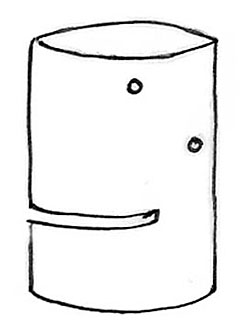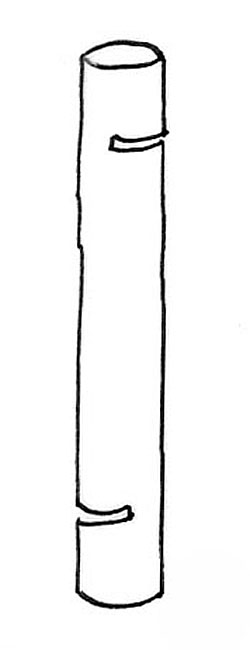Instructions for inoculating logs with grain spawn
Inoculating by putting grain spawn into a saw cut in the log or into a large hole is a bit harder to do than using inoculated plugs. This is because you need either a chain saw to cut the slot or a large diameter drill bit and powerful drill to make the holes. Instead of simply pushing plugs into 8 mm holes, you need to put the grain spawn into the slot or large hole using a spoon or funnel and tamp it down with a flat or round piece of wood. Grain spawn consists of special grains like millet which are inoculated with the mushroom mycel.
Advantages of using grain spawn:
- The mycel grows into the logs somewhat faster and thus the first mushrooms usually appear a bit earlier.
Grain spawn is above all helpful if you are inoculating thicker logs with a large diameter.
Example of Shiitake: You should normally use logs with a diameter of 10 to 15 cm. If you can only get hold of thicker logs then it is recommended to use grain spawn rather than plugs.
Disadvantages compared to inoculated plugs:
- Somewhat harder to do since you need a chainsaw or powerful drill.
- Grain spawn is somewhat more sensitive than inoculated plugs and you should avoid storing it over an extended period.
- The inoculated grain in the logs can attract mice which like to eat it.
Instructions for inoculating using a saw cut or large hole

Saw cut inoculation with a couple of additional holes
a) Inoculation of stump logs
(20 cm diameter, height 35 - 40 cm)
1 litre of grain spawn is enough to inoculate approx. 6-7 logs with the above shape and size. Many mushroom types such as oyster mushrooms grow well on stump-shaped logs (only shiitake mushrooms need long thin logs, see below). If you want to inoculate logs with diameter about 20 cm and height about 35 cm, you only need a single saw cut at a height of approx. 15 cm from the end of the log. Cut a slot with a (chain) saw about half to max. 2/3 of the way through the log. Then put the grain spawn into the slot using a spoon or funnel and tamp down with a flat piece of wood such as the end of a ruler.
Then close the slot with wide packaging tape, fixing with drawing pins too if necessary. Use transparent tape if possible - then you can see how fast the mycelia grows from the grain spawn into the log. To encourage the top half of the wood to populate quickly too (and if you have some spare grain spawn), it helps to drill several large holes in the cut end (min. 14 mm diameter) and to fill them with grain spawn. Afterwards, you can seal the holes with candle wax, cork or round wood discs. Drill slowly! If the wood gets overheated during drilling, this can lead to the formation of a varnish-like coating inside the hole which cannot easily be penetrated by the mycelia!.

Inoculation of logs for shiitake
b) Inoculation of logs for shiitake mushrooms
Shii-take grows best on long thin logs with a length of 100 to 120 cm and a diameter of 10 bis 15 cm. 1 litre of grain spawn is enough to inoculate approx. 5-7 logs with this shape and size.
With these long logs it is best to make two saw cuts, one on each side of the log at the top and the bottom as shown in the picture.
This method has however the following disadvantages: Thin logs can become weakened by the saw cuts, they then become rotten more quickly and can break at the cut. In addition, in contrast to wood plugs, the grain spawn can fall out of the slots. The empty holes may then be used as breeding holes by woodlice or snails, which may then eat the mushrooms. In contrast to the other mushroom types, logs for shitake are not partly buried in the ground.
Conclusions / Alternatives
If you want to use grain spawn for inoculating long thin logs for shiitake mushrooms drilling large holes (min. 14 mm diameter) is a good alternative to cutting slots. if you want to use a Forstner bits we recommend you to buy a high-quality one. Better still is a normal drill bit of size 14 mm or more. Then fill the holes with grain spawn and seal the holes with candle wax, cork or round wood discs (same diameter as the drill bit).
Storing the logs after the propagation phase:
Thicker logs or stumps:
After the propagation phase in the covered mound (description: see instructions for using inoculated plugs), the logs are partially buried in the ground at a damp shadowy place with nutrient rich soil. You can now remove the packaging tape. The "short" end of the log closest to the saw cut is buried deep enough in the ground such that the saw cut is completely covered by earth. this ensures that snails or woodlice cannot creep inside. You can then cover the area around the logs with a mulch of shredded wood chips or similar. This ensures that mushrooms growing close to the ground do not get dirty with sand etc. which may be splashed up by rain. In the case of very sick stumps, it also helps to drill 1-3 holes (at least 14 mm diameter) in in the cut face of the log to allow rainwater to seep inside and keep the log damp. This also helps if you need to use a watering can in dry weather.
Thinner logs for shiitake:
After the propagation phase in the covered mound (description: see instructions for using inoculated plugs), the shiitake logs are not buried but placed upright, e.g. by leaning them against a fence or wooden slats.
Download instructions as a pdf file
|